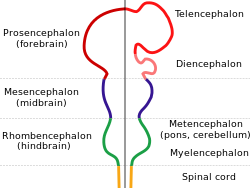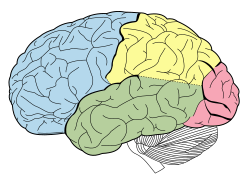Telencephalon
| Cerebrum | |
|---|---|
|
The lobes of the cerebral cortex include the frontal (blue), temporal (green), occipital (red), and parietal (yellow) lobes . The cerebellum (unlabeled) is not part of the telencephalon.
|
|

Diagram depicting the main subdivisions of the embryonic vertebrate brain.
|
|
| Details | |
| Artery | anterior cerebral, middle cerebral, posterior cerebral |
| Vein | cerebral veins |
| Identifiers | |
| Latin | Cerebrum |
| MeSH | A08.186.21.730.885 |
| NeuroLex ID | Cerebrum |
| TA |
14.1.03.008 14.1.09.001 |
| FMA | 62000 |
|
Anatomical terms of neuroanatomy
[]
|
|
The cerebrum is a large part of the brain containing the cerebral cortex (of the two cerebral hemispheres), as well as several subcortical structures, including the hippocampus, basal ganglia, and olfactory bulb. In humans, the cerebrum is the uppermost region of the central nervous system. The telencephalon is the embryonic structure from which the cerebrum develops prenatally. In mammals, the dorsal telencephalon, or pallium, develops into the cerebral cortex, and the ventral telencephalon, or subpallium, becomes the basal ganglia. The cerebrum is also divided into approximately symmetric left and right cerebral hemispheres.
With the assistance of the cerebellum, the cerebrum controls all voluntary actions in the body.
The cerebrum is the largest part of the brain. Depending upon the position of the animal it lies either in front or on top of the brainstem. In humans, the cerebrum is the largest and best-developed of the five major divisions of the brain. The cerebrum is the newest structure in the phylogenetic sense, and in mammals it is the largest and most developed, out of all known species.
The cerebrum is made up of the two cerebral hemispheres and their cortices, (the outer layers of grey matter), and the underlying regions of white matter. Its subcortical structures include the hippocampus, basal ganglia and olfactory bulb. The cerebrum consists of two cerebral hemispheres, separated from each other by a deep fissure called the longitudinal fissure.
...
Wikipedia

